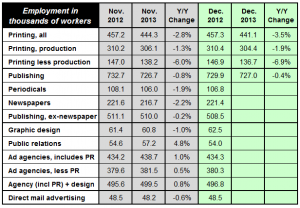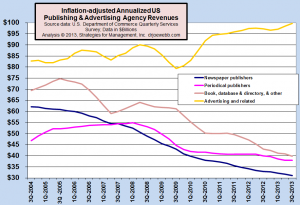US commercial printing industry employment fell -3.5% to 441,100 workers in December. The evidence of consolidation is pretty clear, with production workers declining by -1.9% compared to -6.9% for non-production workers. Printing and publishing industries had declines in employment in 2013. Through November, however, advertising agency employment increased by +1.0%. In that sector, the biggest increase was in public relations employment, which was up +4.8%, or 2600 workers. These data reflect the shift in media allocation in recent years to media that do not involve the purchase of space in print or time in broadcast media. Total advertising employment is likely to pass commercial printing employment sometime in mid-2014. (click to enlarge)

The following chart shows the inflation-adjusted revenue trends for selected content-creation businesses. Note how advertising revenues have increased despite the declines in the revenues to publishers. Agencies have shifted much of their efforts to developing "earned media" (a/k/a search engines, social media, e-marketing and numerous other digital formats), and the production of it. (click to enlarge)

The US Bureau of Labor Statistics recently published an updated Occupational Outlook. The bizarre conclusions of this report over the years are almost legendary, and it comes from its methodology of averaging three years of data for its projections, so it always lags changes. The job outlook for
printing workers states
The employment of printing press operators is projected to decline 4 percent from 2012 to 2022, driven by trends in the printing industry. Their employment is not expected to decline as rapidly as that of prepress technicians, however, because printing press operators are less susceptible to automation.
Printing press operators are less susceptible to automation. Really? That's not the history. There was a time when big sheetfed presses took three or four workers, sometimes more, to operate. Through the 1980s and 1990s, a key justification toward the improved economics of a new press was a decrease in labor cost. The automation found in digital presses certainly has changed the market for press operators. The Occupational Outlook is a favorite of high school guidance counselors because it has the authority of the BLS. No BLS report accurately predicted what has happened to industry employment, and that's not likely to change. Their methodology really has no way of accounting for displacement by other media; it's not designed to. Preparing the Outlook is not an easy task, and is probably impossible to create a great one. In 2006, how many social media planners did they forecast for 2012? They couldn't. Social media didn't exist at that time except as curious and trendy application. Now it's a mainstay of the media mix. You can't run trend lines on stuff that has no history.
# # #
 The following chart shows the inflation-adjusted revenue trends for selected content-creation businesses. Note how advertising revenues have increased despite the declines in the revenues to publishers. Agencies have shifted much of their efforts to developing "earned media" (a/k/a search engines, social media, e-marketing and numerous other digital formats), and the production of it. (click to enlarge)
The following chart shows the inflation-adjusted revenue trends for selected content-creation businesses. Note how advertising revenues have increased despite the declines in the revenues to publishers. Agencies have shifted much of their efforts to developing "earned media" (a/k/a search engines, social media, e-marketing and numerous other digital formats), and the production of it. (click to enlarge)
 The US Bureau of Labor Statistics recently published an updated Occupational Outlook. The bizarre conclusions of this report over the years are almost legendary, and it comes from its methodology of averaging three years of data for its projections, so it always lags changes. The job outlook for printing workers states
The US Bureau of Labor Statistics recently published an updated Occupational Outlook. The bizarre conclusions of this report over the years are almost legendary, and it comes from its methodology of averaging three years of data for its projections, so it always lags changes. The job outlook for printing workers states














